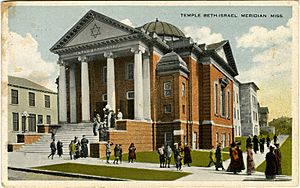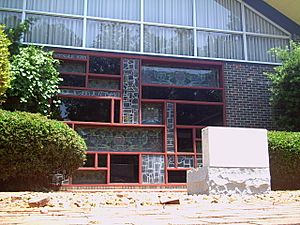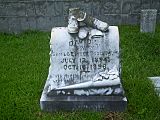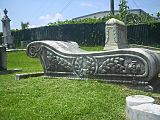Congregation Beth Israel (Meridian, Mississippi) facts for kids
Quick facts for kids Congregation Beth Israel |
|
|---|---|
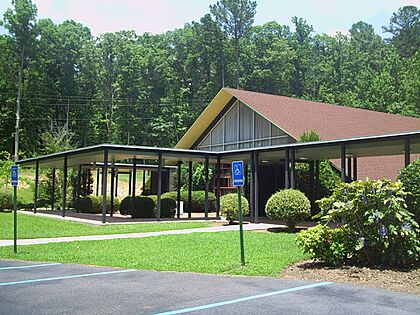
Temple Beth Israel in 2010, from the southwest
|
|
| Religion | |
| Affiliation | Reform Judaism |
| Ecclesiastical or organisational status | Synagogue |
| Leadership | Rabbi Barry Altman (part-time) |
| Status | Active |
| Location | |
| Location | 57th Circuit and 14th Avenue, Meridian, Mississippi |
| Country | United States |
| Architecture | |
| Date established | 1868 (as a congregation) |
| Completed |
|
Congregation Beth Israel is a Reform Jewish synagogue in Meridian, Mississippi. It was started in 1868 and is part of the Union for Reform Judaism. The congregation has had three main buildings over the years.
Their first building, built in 1879, had a Middle Eastern style. In 1906, they moved to a new building that looked like a Greek temple. Since 1964, they have been in a more modern building.
When it first started, the congregation had only ten families. By 1878, it grew to 50 members. In 1906, there were 82 members. By 1927, Meridian had 525 Jewish residents. Today, there are fewer than 40 Jewish people in the city. Most of them are older. The synagogue now has a part-time rabbi.
One important rabbi was Judah Wechsler. A school for African Americans was named after him. Another rabbi was William Ackerman. After he passed away, his wife, Paula Ackerman, became the first woman to lead a Jewish congregation in the country. She performed many duties of a rabbi.
In 1968, the education building of the synagogue was bombed. This was done by members of the Ku Klux Klan. Pieces of glass from the damaged building are now in the front windows of the current synagogue. The congregation also owns a historic cemetery. It is called Beth Israel Cemetery. It was added to the National Register of Historic Places in 1989.
Contents
History of the Synagogue
In the early days, before Meridian was a big city, many Jewish families lived in a nearby town called Marion. These families, along with Jewish people from Meridian, wanted to build a temple. They planned to build it between the two towns.
After the American Civil War, Meridian grew much larger. Marion became smaller. So, many Jewish families from Marion moved to Meridian. In 1868, they formed the first Jewish congregation in the area, Beth Israel. They bought land for their cemetery for $100.
First Synagogue Building (1879)
The congregation started with just ten families. They met in different places at first. These places included a house, a room above a grocery store, and a hall. By 1878, the group had grown to 50 members. David Burgheim was their rabbi.
In 1879, the growing congregation built its first permanent synagogue. It was on 22nd Avenue. This building was the first in Meridian to have gas-powered lights. Rabbi Judah Wechsler became the rabbi in 1887. He helped create public schools for African Americans. The Wechsler School was named after him. It is now a historic landmark. The congregation used this building for many years. They eventually moved because of flies from a nearby store.
Second Synagogue Building (1906)
In 1906, a new synagogue was built. It was designed by architect P.J. Krouse. The building looked like an ancient Greek temple. It had large marble steps and tall columns. This new synagogue could hold 500 people. It had beautiful stained glass windows. These windows showed symbols like the Ten Commandments and the Star of David.
A fire damaged the building in its first year. While it was being fixed, services were held at a nearby church. By 1907, the congregation had 82 members. Rabbi Max Raisin led the group. By 1927, Meridian's Jewish community grew to 525 people. Many new immigrants from Eastern Europe joined. Beth Israel members helped these newcomers. They helped them find jobs and homes. They also taught them English in night classes.
Some members wanted a stricter way of worship. So, a smaller Orthodox group called Ohel Jacob formed in 1895. But the two groups got along well. Many Jewish people in Meridian belonged to both.
In 1951, Beth Israel had 100 members. It was the second largest Jewish community in Mississippi. Rabbi William Ackerman served the congregation for many years. When he suddenly passed away, his wife, Paula Ackerman, was asked to lead. No women had been officially ordained as rabbis yet. But Paula Ackerman served as the "spiritual leader" for three years. She did all the duties of a rabbi. This included leading services, giving sermons, and performing weddings and funerals. Many people across the country talked about this. Some criticized it. But the congregation stayed strong under her leadership.
Third Synagogue Building (1964)
By 1964, the old temple needed repairs. Also, the steep steps were hard for older members to climb. Instead of fixing the old building, they bought land in a new area of Meridian. They built a new synagogue there.
The new building opened in December 1964. It had a sanctuary that could seat 200 people. It also had a social hall, a kitchen, a library, and an education building.
1968 Bombing Incident
During the American Civil Rights Movement in the 1960s, leaders at Beth Israel spoke out. They spoke against attacks on black churches. In response, on May 28, 1968, the education building of Beth Israel was bombed. This attack was carried out by Thomas Albert Tarrants III and Danny Joe Hawkins. They used about 15 sticks of dynamite.
The explosion damaged several walls and part of the roof. It also destroyed a door in the main synagogue building. A large hole was left in the concrete floor. The damage cost about $50,000 to fix. The city offered a reward for information. The Jewish community also offered extra money. Sammy Feltenstein, a past president, said that pieces of stained glass from the bombing were saved. These pieces are now in the front window of the synagogue.
On June 30, Tarrants returned to Meridian. He planned to bomb the home of Meyer Davidson, a Jewish community leader. The FBI and Meridian police were ready. They had been tipped off by informants. Police officers hid around Davidson's house. Tarrants arrived with dynamite. When police told him to stop, he dropped the box and ran. Police chased him. Tarrants shot at the police. One officer was hit but survived. A nearby resident was also hit by stray bullets. Police found Tarrants injured. Another person, Kathy Ainsworth, was found dead in the car. Tarrants survived his injuries. He was later sentenced to prison. After eight years, he was released. He went to college and later trained missionaries.
Beth Israel Cemetery
|
Beth Israel Cemetery
|
|

Beth Israel Cemetery in 2010
|
|
| Location | 19th Street and 5th Avenue, Meridian, Mississippi |
|---|---|
| Area | 2.9 acres (1.2 ha) |
| Built | c. 1868–70 |
| MPS | Meridian MRA |
| NRHP reference No. | 89000169 |
| Added to NRHP | March 22, 1989 |
Besides the main synagogue, the congregation also takes care of Beth Israel Cemetery. It is located at 19th Street and 5th Avenue. This cemetery is listed on the National Register of Historic Places. When it was first bought, it was outside Meridian. Now, the city has grown around it.
The cemetery holds the graves of many generations. These include immigrants from Germany and Alsace. Many important Jewish merchants from the late 1800s and early 1900s are buried here. This cemetery is the only remaining memorial for many early Jewish families in Meridian. Their first two synagogue buildings no longer exist.
A brick fence with iron gates surrounds the cemetery. The gates have an iron Star of David. Inside, there are two main paths. They meet in the middle at a decorative fountain. The oldest graves are in the northern part. Newer graves are in the south. Many graves have beautiful Victorian era art. This art makes the cemetery historically important.
For example, the Winner family grave has a bronze bust of Mark Winner. It also has two marble angels. David L. Rosenbaum's grave has marble shoes and stockings on top. Julius Elson's grave is marked by a carved marble fainting couch. A memorial to Mattimore Meyer features a marble angel.
The cemetery is small, about 2.9 acres. It was designed like a "rural cemetery." Many of the first people buried here were European immigrants. There are no trees on the property. This is because Jewish cemeteries in Europe often do not have trees. They avoid roots disturbing the graves.
Changes in the Jewish Community
The Jewish community in Mississippi has become smaller over time. In 1927, there were 6,420 Jewish people in the state. By 2001, only 1,500 remained. Many children of early Jewish immigrants went to college. They became professionals instead of taking over family businesses. Also, large national stores made it hard for local Jewish-owned businesses. This caused many Jewish families to move to bigger cities.
Meridian's population has also decreased. Between 1980 and 2000, the city's population dropped by over 16%.
By the early 2000s, fewer than 40 Jewish people lived in Meridian. Most were elderly. The local Orthodox congregation, Ohel Jacob, eventually joined Beth Israel in 1990. By the 2000s, there were not enough children for a Sunday school or youth group at Beth Israel.
Beth Israel no longer has a full-time rabbi. From 2005 to 2016, a retired rabbi from New Orleans visited once a month. Since September 2016, Rabbi Barry Altman has served as the part-time rabbi. The synagogue serves about 20 families. It also has a group that works to support the Jewish community in Meridian. In 2010, Beth Israel started a program. It offered grants of up to $25,000 to families who wanted to move to Meridian.



